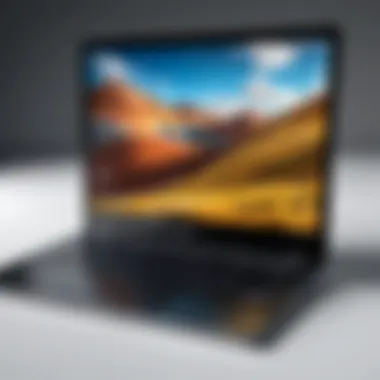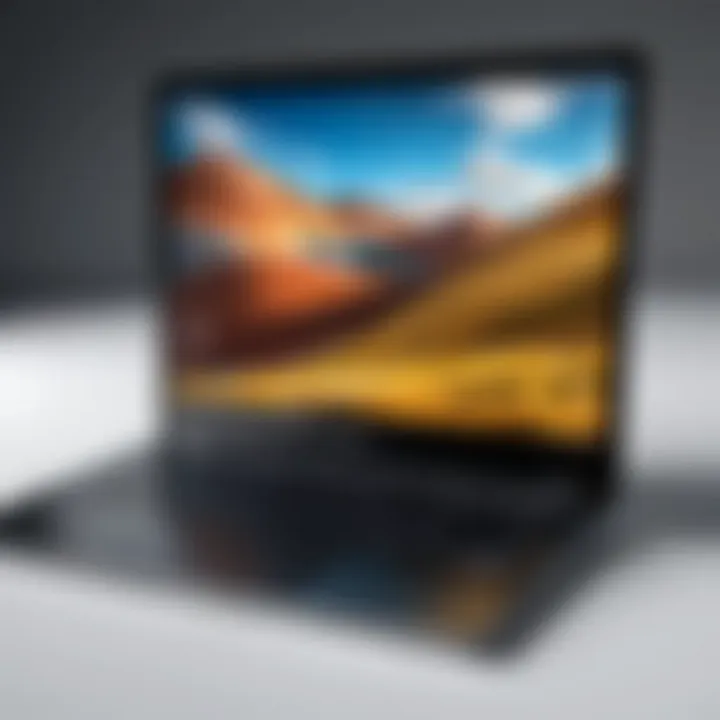Install Windows 10 on Your Chromebook: A Comprehensive Guide


Intro
Installing Windows 10 on a Chromebook can seem like a daunting task, but it is achievable for those willing to explore the possibilities of cross-platform functionality. As Chromebooks gain popularity for their speed and simplicity, tech-savvy individuals and gadget lovers often desire to expand their potential by running more robust operating systems such as Windows. This article guides readers through the methods, compatibility challenges, and prerequisites necessary for installing Windows 10 on a Chromebook. Understanding this process not only allows users to harness the power of Windows applications but also enhances the overall capabilities of their Chromebook.
Overview of the Technology
Key Specifications
Chromebooks are primarily designed to operate on Chrome OS, which is known for its lightweight performance and ease of use. However, some models come equipped with impressive specifications that may support the installation of Windows 10. When considering this transition, check for key specifications such as the processor type, RAM, and storage capacity. A minimum of an Intel Core i3 processor, at least 4GB of RAM, and 32GB of storage is generally recommended for optimal performance of Windows 10. Advanced models like the Google Pixelbook or ASUS Chromebook Flip have the necessary hardware to handle Windows operating system adequately.
Unique Selling Points
The unique selling points of running Windows on a Chromebook primarily revolve around its versatility. Windows offers access to a wide array of applications not available on the Chrome OS ecosystem, from advanced design software to gaming options. By installing Windows 10 on a Chromebook, users enter a realm of enhanced productivity and entertainment, unlocking features that elevate their workflows and leisure activities. Additionally, the seamless integration of cloud services can be retained, ensuring that users benefit from both operating systems.
Design and Build Quality
Material Used
When it comes to design and build quality, Chromebooks typically prioritize portability and durability. Most devices utilize plastic or aluminum materials, which ensures a lightweight construction without compromising sturdiness. For example, a Chromebook like the Lenovo Chromebook Duet features a robust design that can withstand daily wear and tear, making it reliable for both personal and professional use.
Ergonomics and Usability
The ergonomics of Chromebooks contribute significantly to their usability. Generally, Chromebooks are designed with comfortable keyboard layouts, decent trackpads, and displays that reduce eye strain. Users will find that these factors enhance their overall computing experience. While using Windows 10, the touchpad responsiveness and keyboard shortcuts may differ slightly due to the operating system's nuances, but the transition remains manageable with some practice.
"Installing Windows on a Chromebook is not just about compatibility, it's about enhancing your device's potential beyond its original limits."
In summary, though Chromebooks initially cater to a specific operating environment, their technological framework can adapt to run Windows 10. By understanding their specifications, leveraging their unique properties, and appreciating their design features, users can make an informed decision on this endeavor.
Preface
In the realm of technology, the desire to maximize devices' capabilities often leads to inquiries into cross-platform compatibility. One such area of interest has emerged with the question: can one effectively download and run Windows 10 on a Chromebook? This topic is increasingly relevant, fueled by the rising popularity of Chromebooks in both educational and professional environments. Understanding the implications of this endeavor requires a careful examination of various elements.
The importance of this topic lies in several key areas. First, many users are accustomed to the Windows environment and prefer its ecosystem for productivity applications. They may find Chromebooks limiting, thus seeking ways to enhance their functionality. Second, with the evolution of computing needs, individuals often look for solutions that offer versatility without investing in new hardware. This makes the ability to run Windows on existing devices particularly appealing.
However, there are considerations to keep in mind. Compatibility issues can arise, especially around hardware. Chromebooks are designed primarily to run Chrome OS, which emphasizes web-based applications. Attempting to install Windows may lead to performance challenges, which can affect usability. Therefore, it becomes essential to weigh the benefits against the potential hurdles.
This article will guide you through the methodologies available for downloading Windows 10 on a Chromebook. It will also cover the technical requirements, practical applications, and potential pitfalls associated with this process. By addressing these points, the aim is to equip readers with a comprehensive understanding of the feasibility, advantages, and possible drawbacks of this cross-platform undertaking.
"The attempt to merge two different operating environments demonstrates the ever-changing landscape of user needs and technological advancements."
Ultimately, this exploration will empower tech-savvy individuals to make informed decisions about their devices, adapting their use to align with personal or professional requirements.
Understanding Chromebooks
The significance of comprehending Chromebooks is central to this exploration of installing Windows 10. This understanding helps users make informed decisions and adapts their expectations regarding system capabilities. Chromebooks are designed for efficiency, primarily relying on web-based applications and cloud storage. Knowing this is important for anyone considering running alternative operating systems like Windows.
One central element is the operating system. Chromebooks operate on Chrome OS, which is lightweight and optimized for online tasks. This design yields benefits such as quick boot times and extended battery life. However, these features come at a cost, specifically limiting the range of compatible software. Many users accustomed to Windows applications may find the transition challenging.
Furthermore, recognizing the limitations of hardware within Chromebooks is essential, particularly when evaluating potential performance issues that may arise from running Windows 10. Many Chromebook models are equipped with lower-end processors and limited RAM compared to standard laptops. This discrepancy can lead to performance bottlenecks when attempting to run resource-intensive applications that are common in Windows environments.
In summary, a clear understanding of Chromebooks is key. It allows users to grasp what tasks they can perform effectively and what challenges they may face. This insight serves as a guide when exploring options for installing Windows 10, ensuring users approach this endeavor with realistic expectations.
Operating System Overview
Chrome OS is fundamentally different from traditional operating systems. Built on the Linux kernel, it prioritizes web applications and services. Users will find that most software they are accustomed to using on Windows might not be directly available. While many popular tools have web-based versions, it is essential to understand that functionality can differ significantly.
Additionally, updates and usability of Chrome OS enhance its performance. Automatic updates ensure that the system remains secure and efficient. This focus on security reduces the need for extensive anti-virus measures, a stark contrast from Windows environments where such software is often necessary.
Hardware Limitations
Chromebooks come equipped with varying specifications, which limits their functionality compared to higher-end laptops. Many models feature ARM processors or lower-tier Intel chips, designed for energy efficiency rather than heavy computational power. This limitation can pose challenges when attempting to run an operating system as demanding as Windows 10.
- Processor: Many models run on low-power processors that lack the capability to handle Windows 10 effectively. This can quickly lead to sluggish performance.
- Memory and Storage: Commonly, entry-level Chromebooks possess just 4GB of RAM and limited storage, typically in the range of 32GB to 64GB. This non-expandable storage can be a significant constraint, especially when Windows requires at least 20GB of free space for installation.


In essence, to efficiently run Windows 10 on a Chromebook, users must consider whether their chosen model meets the necessary specifications or if they might encounter performance issues. Understanding these hardware limitations is crucial before attempting any cross-platform endeavors.
Windows System Requirements
Understanding the Windows 10 system requirements is crucial for any user looking to install the operating system on a Chromebook. These specifications not only ensure the smooth functioning of the OS but also inform users about the potential limitations of their hardware. Windows 10 may demand resources that some Chromebooks simply do not possess. By highlighting these requirements, this section aims to lay a foundation for what is necessary to successfully run Windows 10 on a Chromebook, informing users about both the minimum and recommended specs that they should consider.
Minimum Hardware Specs
The minimum hardware specifications serve as a baseline for loading and running Windows 10. These specs define the lowest acceptable standards for performance, but opting for minimum requirements can lead to a suboptimal user experience.
The essential minimum hardware specifications for Windows 10 include:
- Processor: 1 GHz or faster compatible 32-bit or 64-bit processor.
- RAM: At least 1 GB for 32-bit or 2 GB for 64-bit.
- Storage: 16 GB for 32-bit or 20 GB for 64-bit.
- Graphics card: DirectX 9 or later with WDDM 1.0 driver.
- Display: A display of at least 800 x 600 resolution.
If a Chromebook meets these minimum requirements, it can technically run Windows 10. However, users may quickly face challenges such as longer loading times, sluggish performance, and reduced multitasking capabilities. Hence, while these minimum specs are vital to know, they should not be the endpoint of consideration for prospective users.
Recommended Specifications
In contrast to minimum specs, the recommended specifications outline the ideal conditions under which Windows 10 can perform efficiently. Achieving these specifications will lead to less frustration and a more responsive operating system. Users are encouraged to aim for these higher benchmarks to fully leverage what Windows 10 offers.
The recommended hardware specifications for Windows 10 are:
- Processor: 1 GHz or faster dual-core processor.
- RAM: At least 4 GB.
- Storage: 64 GB or larger.
- Graphics card: DirectX 10 compatible.
- Display: A display with a resolution of at least 1366 x 768.
Meeting or exceeding the recommended specifications will allow users to handle a greater array of applications without encountering performance lag. It provides better support for multitasking and advanced features within Windows 10, such as graphical enhancements and faster processing speed.
"For best results, aim for the recommended hardware specifications rather than the minimum, particularly on devices with limited resources like Chromebooks."
In summary, understanding both the minimum and recommended hardware specifications is essential for determining the viability of running Windows 10 on a Chromebook. Users should assess the specs of their devices against these requirements for a clear guide to potential performance and usability.
Methodologies for Downloading Windows on Chromebook
The methods for downloading Windows 10 on a Chromebook involve both technical aptitude and understanding the limitations inherent to the Chromebook architecture. This section outlines various methodologies, focusing on how each approach can help users achieve their goal while highlighting the benefits and considerations of each. Installing Windows on a Chromebook can unlock additional functionalities, but requires careful planning and execution to avoid potential pitfalls.
Using Crostini
Crostini is a tool designed by Google to facilitate running Linux applications on ChromeOS. While it mainly supports Linux software, users have found ways to extend its functionality towards Windows applications. This pathway taps into the Linux subsystem, although directly downloading Windows is not feasible through this method. Instead, it allows users to run certain Windows applications through compatibility layers. This offers a medium for tech-savvy individuals to experiment with Windows-like functionality within the constraints of their Chromebooks.
Benefits:
- Access to a Linux environment: Users can utilize Linux applications alongside Windows-like software.
- Seamless Integration: Crostini operates natively within ChromeOS, resulting in smoother performance for compatible applications.
Considerations:
- Limited Application Library: Not all Windows applications are compatible; performance may vary greatly.
- Technical Knowledge Required: Users must be adept at using the terminal to set up and configure Crostini effectively.
Installing via Virtual Machine
Another methodology involves using a virtual machine (VM) to run Windows on a Chromebook. Software like VirtualBox can be utilized to create a virtual environment. This method allows users to install Windows just as they would on a traditional PC. However, it requires substantial resources and compromises performance, particularly on entry-level devices.
Benefits:
- Full Windows Experience: Users can run applications as if they were using a native Windows environment.
- Reversible Installation: If users no longer require Windows, uninstalling the VM is straightforward.
Considerations:
- Performance Limitations: Chromebooks generally possess less power than dedicated PCs, which can lead to slow performance.
- Storage Space: Users must account for the additional space Windows and the virtualization tools will consume.
Booting from USB Drive
Booting Windows from a USB drive is perhaps the most direct approach. This involves creating a bootable USB installation for Windows and configuring the Chromebook to boot from it. This method can take advantage of the full capabilities of Windows, without the restrictions of ChromeOS.
Benefits:
- Direct Access to Windows: Users can operate Windows natively without the limitations found in other methodologies.
- Use of Full Hardware Resources: Running Windows directly can utilize the hardware effectively.


Considerations:
- Technical Setup Required: This method demands a certain level of technical knowledge to create the bootable drive and adjust BIOS/UEFI settings.
- Potential Data Loss: Incorrect setup might lead to data loss or corruption, particularly if partitions are not managed properly.
It is essential for users to weigh these methodologies based on their individual requirements and technical skill levels. Each method presents distinct advantages and challenges that must be considered carefully.
Alternatives to Running Windows on Chromebook
In the discourse surrounding installing Windows 10 on a Chromebook, the idea of exploring alternatives holds significant value. It not only reassures users who may face complications during installation but also broadens the appeal of Chromebooks in general. While the intent to run an operating system that's traditionally alien to Chromebooks may seem compelling, other methodologies exist. These methods can effectively fulfill user needs without the often daunting hurdles of a full installation.
When considering alternatives, it is crucial to weigh their benefits and suitability for different user scenarios. Users should evaluate performance, compatibility, and security. These factors ultimately shape the experience of running Windows applications on a Chromebook, especially for tech-savvy individuals who are accustomed to exploring innovative solutions.
Windows Emulators
Windows emulators serve as a practical alternative for users looking to enjoy Windows applications on their Chromebooks without installing the entire operating system. An emulator creates a virtual environment mimicking the features of Windows, allowing certain applications to run within that space. Popular options include Wine and CrossOver. These tools differ in complexity and compatibility, but they can effectively run many Windows applications on a Chromebook.
Users will appreciate that emulators require fewer system resources compared to a full Windows installation and offer a simpler setup process. However, not all applications function seamlessly, and users can encounter performance issues with resource-intensive software. Testing the specific software need is advisable before committing to an emulator, as experience may vary based on application requirements and hardware capabilities.
Some key considerations related to Windows emulators include:
- Compatibility with various Windows applications
- The learning curve for setup and use
- Performance limitations compared to native execution
In summary, for users focused on executing specific Windows programs without major alterations to their Chromebook, emulators can offer a viable option.
Remote Desktop Solutions
Remote desktop solutions represent another effective alternative that enables users to access a Windows environment hosted elsewhere. This approach typically involves using applications such as Microsoft Remote Desktop or Chrome Remote Desktop. Such solutions work by connecting the Chromebook to a Windows computer that acts as the host, allowing users to interact with the Windows interface remotely.
Adopting remote desktop solutions provides several advantages:
- Accessing a full-fledged Windows environment without local installation
- Utilizing existing Windows software seamlessly across devices
- Minimal impact on local hardware capabilities
But there are also critical aspects to consider. Performance largely depends on internet connectivity. A stable and fast connection is necessary for an optimal user experience. Additionally, there can be latency when operating remote sessions, which may hinder productivity, particularly during tasks that require real-time interaction.
To summarize the approach with remote desktop solutions: it bridges the gap by redirecting Windows needs via a connection to another machine, thus preserving resources on the Chromebook itself.
Challenges and Risks
Understanding the challenges and risks associated with installing Windows 10 on a Chromebook is essential for anyone considering this venture. It is not simply a matter of following a few steps; there are many factors to weigh. Being aware of potential performance issues, data security concerns, and warranty implications is critical for making an informed decision. Each of these aspects can significantly affect not only the practical functionality of the Chromebook but also the overall user experience.
Performance Issues
The first challenge to consider is performance. Chromebooks are designed primarily to run Chrome OS, which is optimized for web-based applications and cloud services. When attempting to run Windows 10, users may encounter significant issues. Windows tends to demand more resources than what typical Chromebooks offer. This means that even if Windows does install successfully, it may run slowly or crash frequently.
Additionally, certain hardware components, such as the CPU and RAM, may not meet the minimum requirements for smooth function of Windows 10. As a result, tasks that are routine on a standard Windows machine may become arduous or frustrating on a Chromebook, leading to an overall unsatisfactory experience, especially with resource-heavy applications like video editing software.
Data Security Concerns
Another pressing issue involves data security. Chromebooks offer robust security features when running Chrome OS, but introducing Windows changes the landscape completely. Windows is often a target for malware and viruses. If users do not take necessary precautions, they may expose their data to unnecessary risks.
Moreover, many Windows applications require complex permissions and configurations, which could inadvertently lead to data vulnerabilities. Users should consider using a reliable antivirus solution and maintain regular updates to mitigate these risks. Keeping data secure while operating Windows on a Chromebook is a serious concern that requires proactive measures.
Warranty and Support Implications
Lastly, there are warranty and support implications to consider. Installing Windows on a Chromebook may void the original warranty from the manufacturer. This means that if any hardware or software problems arise, users may find themselves without support from the manufacturer. Most companies do not provide assistance for unauthorized operating system installations.
Users should also be aware that troubleshooting issues will likely be more complex and time-consuming. This complexity could lead to added frustration, particularly if users lack the technical know-how to navigate potential problems. In essence, while Chromebooks can offer flexibility, the act of installing Windows introduces several challenges that could ultimately outweigh perceived benefits.
Practical Use Cases
The ability to run Windows 10 on a Chromebook opens up multiple practical use cases for users. These scenarios significantly enhance the utility of a device that is traditionally limited to web-based applications and Google's operating system. Exploring these use cases can give users a clearer picture of how to maximize their Chromebook experience.
One of the most evident use cases is running specific Windows applications that are not available on Chrome OS. Many professional tools and software, such as Adobe Creative Suite or certain development environments, only operate on Windows. By installing Windows 10, users can access these tools seamlessly. This is crucial for those who rely on specific applications for work or personal projects.


Running Windows Applications
Running Windows applications on a Chromebook is a significant benefit for users seeking versatility. Compatibility issues often arise with software designed for Windows. However, using Windows 10 allows users to bypass these limitations, enabling them to utilize software that would otherwise be incompatible.
Some applications, especially in fields like graphic design, engineering, or software development, may not have direct alternatives in Chrome OS. For instance, engineering students may require programs like AutoCAD or MATLAB, which are not available on Chrome OS.
Additionally, many corporate environments depend on proprietary software exclusively available on Windows. This need for specialized applications is a key reason why users might opt to install Windows on their Chromebooks.
Gaming on a Chromebook
Gaming is another notable consideration when discussing Windows on a Chromebook. While Chromebooks are not traditionally known for gaming, Windows 10 enables users to access a broader range of games, including high-demand titles that require Windows-native support.
Running games designed for Windows can lead to a more enjoyable gaming experience with better graphics and performance compared to browser-based games. Many popular games such as "Call of Duty" or "The Witcher" run natively on Windows. By installing Windows 10, users can take advantage of the Steam platform, Epic Games Store, and other gaming services, elevating the functionality of their devices beyond basic tasks.
"Having Windows on my Chromebook has transformed my device into a versatile tool, allowing me to run essential applications and enjoy gaming without limits."
— A satisfied user
Running Windows 10 on a Chromebook does offer significant advantages. Access to essential applications and the ability to dive into gaming does broaden the Chromebook's use cases considerably. However, users should also consider potential performance limitations due to hardware restrictions. It is prudent to research each use case's requirements against what the Chromebook can support before proceeding.
User Experiences
User experiences are crucial in understanding the feasibility of installing Windows 10 on a Chromebook. The perspectives of those who have attempted this installation provide valuable insights into not only the technical challenges but also the practical implications of running Windows on a device primarily designed for Chrome OS. By investigating real-world scenarios, potential users can gauge whether this endeavor aligns with their needs and expectations.
Success Stories
Many users have successfully installed Windows 10 on their Chromebooks. These success stories are not just testimonials, but they serve as guides for others considering the same path. For instance, some users have managed to run Windows applications seamlessly alongside Chrome OS, achieving a hybrid setup that maximizes the use of both operating systems. They often highlight the benefits of having access to software that is not natively supported on Chromebook, especially for tasks that require specific software tools.
Experiences shared in forums like Reddit show that users have successfully managed to optimize system performance by adjusting specific settings within the virtual machines or emulators used for installation. These adjustments include allocating sufficient RAM and CPU resources to ensure smooth operation.
In addition, users frequently report modest improvements in productivity and flexibility. The ability to switch between Windows and Chrome OS can cater to various tasks, making it an attractive solution for many. Notably, a frequent sentiment is how this dual environment bridges the gap between simplicity and functionality.
Common Pitfalls
Despite the success stories, many users encounter challenges when installing Windows 10 on their Chromebooks. These common pitfalls illustrate the intricacies involved in such a process.
One primary issue is performance degradation. Users often report that running Windows in a virtual environment on a Chromebook can lead to sluggish operation, particularly if the hardware specifications are not robust enough. This scenario can lead to frustration, especially for those who anticipate a smooth experience.
Another common issue pertains to software compatibility. Some users find that certain applications fail to function correctly or do not run at all. This limitation contradicts the very aim of running Windows applications on a Chromebook, thus necessitating additional research into compatible alternatives.
Moreover, the installation process can pose significant roadblocks. Users may struggle with setting up virtual machines or configuring USB drives for booting. If users are not familiar with Linux command lines or the intricacies of BIOS settings, they may face overwhelming challenges, making the installation process feel daunting. These experiences underscore the importance of researching and preparing thoroughly before attempting to download and run Windows on a Chromebook.
Ending
In summarizing the complexities surrounding the installation of Windows 10 on a Chromebook, this article brings to light critical considerations for tech enthusiasts and gadget lovers. The allure of running Windows applications on a Chromebook is significant, especially for users who seek enhanced functionality beyond what Chrome OS offers. However, it is essential to acknowledge both the potential benefits and the inherent challenges.
Installing Windows allows access to a vast array of applications, especially for those heavily reliant on Windows-based software environments. This can benefit users who work in specific fields, including design, engineering, or gaming. Nevertheless, the methods, whether through Crostini, virtual machines, or USB drives, require a clear understanding of system capabilities and user intent.
Challenges also deserve emphasis. Performance limitations, security risks, and warranty voids can create barriers that must be navigated carefully. Each approach has its prerequisites and potential pitfalls, making research and preparation paramount. Users need to be realistic about what they can accomplish based on their hardware specifications and technical know-how.
Ultimately, the journey of installing Windows on a Chromebook is not merely about achieving another layer of utility. It signifies a deeper exploration of cross-platform capability, where understanding and adaptation are required. As users experiment with this hybrid setup, they can broaden their experiences and redefine the potential of their devices. For those committed to maximizing their productivity and harnessing the versatility of technology, this endeavor may well be worth the effort.
"Understanding the feasibility of Windows 10 on a Chromebook underscores the intersection of hardware limitations and user preferences."
The insights provided aim to guide interested users toward informed decisions, ensuring that their attempts align with their ultimate goals. This conlusion reinforces the importance of weighing options carefully before venturing into such installations.
Resources and Further Reading
Understanding how to download Windows 10 on a Chromebook can be complex. Therefore, resources and further reading offer critical support for users navigating this technical landscape.
Access to reliable resources ensures users can effectively explore various methodologies. Articles, forums, and official documentation provide step-by-step instructions. They also clarify technical terminology that may seem ambiguous at first.
For example, forums like reddit.com can act as discussion venues. Here, users share personal experiences and troubleshooting tips. They may also highlight methods that have worked for them, which can be invaluable when facing obstacles.
Official resources from Microsoft can provide insight into Windows specifications and compatibility. This is crucial because running Windows on non-Windows hardware can lead to mistakes. By consulting these materials, users can better understand the implications of their choices.
Benefits of Further Reading
- Gain Knowledge: Extensive reading helps users build a foundational understanding of operating system dynamics and hardware requirements.
- Stay Updated: Technology evolves quickly. Following reliable sources can keep users informed of the latest updates or changes regarding Windows and Chromebook functionality.
- Community Support: Engaging in forums fosters a sense of community where users can ask questions and exchange ideas with others who share similar interests.
- Troubleshooting Help: Resources often include sections dedicated to solving common issues, facilitating smoother installations and operations.
Considerations
When seeking further reading materials, consider the credibility of the source. Misinformation can lead to errors and frustrations. Stick to well-known websites, forums, and documentation that offer substantial and detailed guidance. For example, en.wikipedia.org is a reputable site for basic definitions and concepts, while britannica.com may offer a more scholarly approach to the topic.





